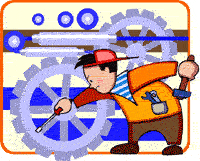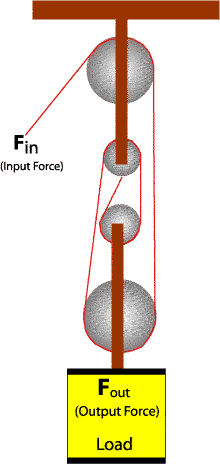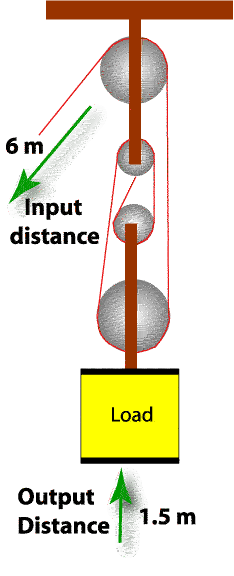Week 22 - Mechanical Advantage, Speed Ratio and Gears
3. MA & SR
.
Lesson 6
Lesson 6: Mechanical Advantage & Speed Ratios
| In this set of lessons you are going to learn about the relationship between speed and force and how to create a machine which will give you either the speed or force advantage you want. |  |
Part 1: Calculating Mechanical Advantage
The mechanical advantage of a machine explains how much a machine can multiply the force that goes into it. Here's how to find the mechanical advantage of a machine:
For example: If the input force is 30 N and the output force is 120 N, calculate the mechanical advantage. |
 |

That means that the machine made it 4 times easier to lift than if you had to lift the load by yourself, without the machine.
The only thing that a single pulley does is change the direction. You must use 2 pulleys to cut down on the effort by half. Check out pages 280 and 281. They show 2 different sets of pulleys.
The first pulley on page 280 shows 4 pulleys and 5 cords but only has a mechanical advantage of 4.
The smaller one on page 281 only has 2 pulleys and 3 cords but only has a mechanical advantage of 2. Unless it is not a fixed pulley. Then one end of the rope is suspended so the effort is reduced by half.
An easy way to think of it as if the downward pulling rope (where the force is applied) is not being counted as part the mechanical advantage because it only changes the direction of the force.
Check out these web sites to see it in action. Once you have viewed and read the first page go to the bottom to the next page about pulleys.
http://www.technologystudent.com/gears1/pulley7.htm
Part 2: Calculating Speed Ratios
In the second part of this lesson we are going to look at another way of analyzing how machines work. We are going to measure the affect a machine has on speed. Speed is the measure of the distance an object moves in a given amount of time. For example, your truck or car measures speed in kilometres per hour while the measure of the speed of light is calculated in km/s (light travels at 300 000 km/s). In our lesson we are going to determine the affect a machine has on the speed of an object. This measurement is called the speed ratio . If this sounds confusing, think of it this way. You can run at perhaps 10 km/hr, but not for very long. If you get on your bike you can travel much faster and for longer periods of time. The speed ratio (SR) is found by dividing the input distance by the output distance. Lets go back to the pulley system we used before to see how this works.
Here's the calculation of the speed ratio in our example:

But what does this number mean?
In means that the input part of the pulley is moving four times faster than the output which is connected to the load. If we reflect back to the section on mechanical advantage you will see that it was 4 as well. Is there a connection between the two measurements?
In the second part of this lesson we are going to look at another way of analyzing how machines work. We are going to measure the affect a machine has on speed. Speed is the measure of the distance an object moves in a given amount of time. For example, your truck or car measures speed in kilometres per hour while the measure of the speed of light is calculated in km/s (light travels at 300 000 km/s). In our lesson we are going to determine the affect a machine has on the speed of an object. This measurement is called the speed ratio . If this sounds confusing, think of it this way. You can run at perhaps 10 km/hr, but not for very long. If you get on your bike you can travel much faster and for longer periods of time. The speed ratio (SR) is found by dividing the input distance by the output distance. Lets go back to the pulley system we used before to see how this works.
| When you want to measure the speed ratio (SR) of a machine you need to measure the input distance and the output distance. In the case of the example to the right the measured distances are: Input distance = 6 m Output distance = 1.5 m |
 |

But what does this number mean?
In means that the input part of the pulley is moving four times faster than the output which is connected to the load. If we reflect back to the section on mechanical advantage you will see that it was 4 as well. Is there a connection between the two measurements?
If you want the work to be easier you must do it over a longer distance!
© 2002 Alberta Online Consortium
